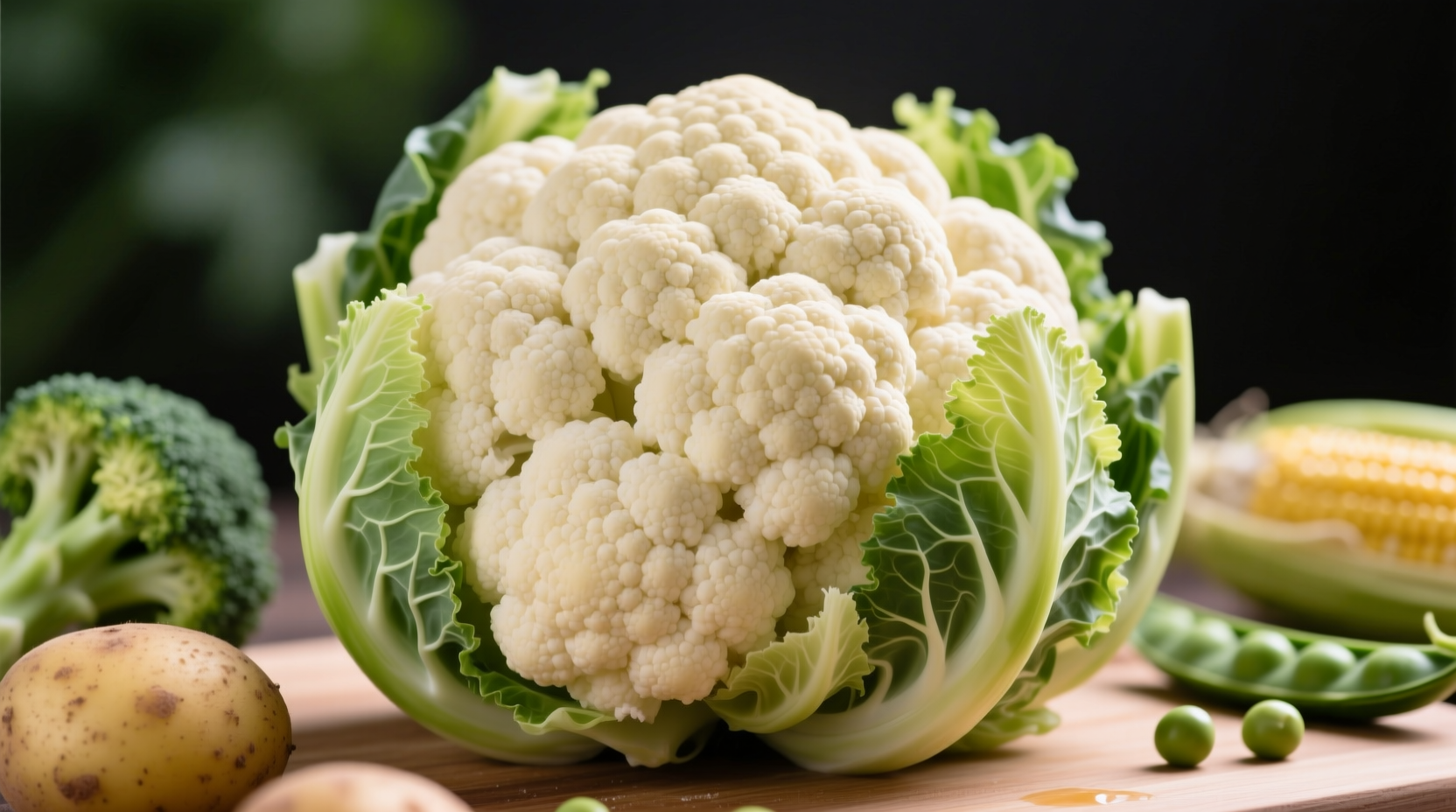When planning meals for specific dietary needs, understanding vegetable classifications becomes crucial. Many people wonder whether cauliflower fits into the starchy category, especially as it's increasingly used as a substitute for higher-carb foods like rice and potatoes. Let's clarify this common nutrition question with evidence-based information that can help you make informed dietary choices.
What Defines a Starchy Vegetable?
Vegetable classification in nutrition science follows specific carbohydrate thresholds. According to the American Diabetes Association, starchy vegetables contain approximately 15 grams or more of carbohydrates per standard serving (typically ½ cup cooked or 1 cup raw). These vegetables derive most of their calories from complex carbohydrates and starch.
Non-starchy vegetables, by contrast, generally contain less than 10 grams of carbohydrates per serving and are lower in calories. They're rich in vitamins, minerals, and fiber while having minimal impact on blood sugar levels. This classification matters significantly for people managing diabetes, following low-carb diets, or watching their carbohydrate intake.
Cauliflower's Nutritional Profile: The Facts
According to USDA FoodData Central, one cup (100g) of raw cauliflower contains:
| Nutrient | Amount per Cup (100g) | % Daily Value* |
|---|---|---|
| Total Carbohydrates | 5g | 2% |
| Dietary Fiber | 2g | 7% |
| Net Carbs | 3g | - |
| Protein | 2g | 4% |
| Vitamin C | 77% DV | 77% |
*Percent Daily Values based on a 2,000 calorie diet
This nutritional profile clearly places cauliflower in the non-starchy category. The Academy of Nutrition and Dietetics confirms that vegetables like cauliflower, broccoli, and leafy greens fall into the non-starchy classification due to their lower carbohydrate density compared to potatoes, corn, peas, and winter squash.
Starchy vs. Non-Starchy Vegetables: Clear Comparison
To understand the significant difference, consider this comparison of common vegetables:
| Vegetable | Carbs per ½ Cup Cooked | Classification | Net Carbs |
|---|---|---|---|
| Cauliflower | 2.5g | Non-starchy | 1.5g |
| Broccoli | 3g | Non-starchy | 2g |
| Carrots | 6g | Non-starchy | 5g |
| Green Beans | 4g | Non-starchy | 3g |
| Peas | 12g | Starchy | 10g |
| Corn | 15g | Starchy | 13g |
| Potatoes | 15g | Starchy | 14g |
Source: USDA FoodData Central (accessed 2025)
Why the Confusion About Cauliflower?
The misconception that cauliflower might be starchy likely stems from its increasing popularity as a substitute for starchy foods. Food manufacturers and recipe developers often position cauliflower as a "rice," "mashed potato," or "pizza crust" replacement, which creates an association with higher-carb foods. However, this usage is precisely because cauliflower offers a low-carb alternative to these starchy options.
Registered dietitians at the Mayo Clinic note that while cauliflower can mimic the texture of starchy foods when prepared certain ways, its fundamental nutritional composition remains that of a non-starchy vegetable. The confusion often arises when people equate culinary usage with nutritional classification.
Practical Implications for Your Diet
Understanding that cauliflower is non-starchy has several practical benefits for different dietary approaches:
For Low-Carb and Keto Diets
With only 3g of net carbs per cup, cauliflower fits comfortably within most low-carb and ketogenic diet parameters. Many keto dieters use cauliflower rice as a staple because it provides volume and texture with minimal carb impact compared to traditional rice (which contains about 45g net carbs per cup).
For Diabetes Management
The American Diabetes Association specifically recommends non-starchy vegetables like cauliflower as "free foods" that can be eaten in generous portions without significantly affecting blood glucose levels. This makes cauliflower an excellent choice for creating satisfying meals while managing carbohydrate intake.
For Weight Management
Because cauliflower is low in calories (about 25 calories per cup) yet high in volume and fiber, it can help create the feeling of fullness without excess calories. This "volume eating" approach is supported by research from the National Institutes of Health as an effective weight management strategy.
Culinary Flexibility Without the Carbs

One reason cauliflower has gained such popularity is its remarkable culinary versatility. Unlike truly starchy vegetables, cauliflower can transform to mimic various textures while maintaining its low-carb profile:
- Cauliflower rice: Pulse florets in a food processor for a rice substitute with 90% fewer carbs
- Cauliflower mash: Boil and blend with healthy fats for a mashed potato alternative
- Cauliflower pizza crust: Combined with cheese and eggs for a low-carb pizza base
- Cauliflower steaks: Thick slices roasted for a substantial vegetarian main
These preparations showcase cauliflower's unique ability to serve as a canvas for flavors while keeping carbohydrate content low—a quality that true starchy vegetables cannot match.
Contextual Considerations: When Classification Matters Most
While cauliflower is definitively non-starchy, certain contexts require special attention:
- Medical nutrition therapy: For people with diabetes following carb-counting protocols, understanding that cauliflower counts as a non-starchy vegetable allows for more flexible meal planning
- Surgical dietary protocols: After certain gastrointestinal surgeries, even non-starchy vegetables may need to be limited initially
- Specific therapeutic diets: Some medically supervised diets like the Specific Carbohydrate Diet have unique classifications that may treat certain non-starchy vegetables differently
Nutrition professionals emphasize that while general classifications are helpful, individual responses to foods can vary. People with specific health conditions should consult registered dietitians for personalized guidance.
Debunking Common Misconceptions
Several myths persist about cauliflower's carbohydrate content:
- Myth: "Cauliflower turns into sugar in your body just like potatoes do."
Fact: With only 3g net carbs per cup versus 14g in potatoes, cauliflower has significantly less impact on blood sugar. - Myth: "All white vegetables are starchy."
Fact: This is incorrect—cauliflower, mushrooms, and onions are white but non-starchy, while sweet potatoes (orange) are starchy. - Myth: "Cauliflower contains hidden starches."
Fact: Scientific analysis shows cauliflower contains negligible starch—its carbohydrates are primarily simple sugars and fiber.
Practical Tips for Incorporating Cauliflower
Now that you understand cauliflower's place as a non-starchy vegetable, here are evidence-based ways to maximize its benefits:
- Maximize nutrient retention: Steam or roast rather than boil to preserve water-soluble vitamins
- Boost absorption: Pair with healthy fats (olive oil, avocado) to enhance absorption of fat-soluble vitamins
- Portion guidance: For most diets, you can enjoy cauliflower freely without strict portion control
- Variety matters: Try different colors (orange, purple, green) for slightly varied nutrient profiles
Registered dietitians recommend incorporating at least 3-5 servings of non-starchy vegetables like cauliflower daily as part of a balanced eating pattern. The Dietary Guidelines for Americans consistently emphasize non-starchy vegetables as foundational components of healthy eating patterns.
Conclusion: Clear Classification, Practical Benefits
Cauliflower's classification as a non-starchy vegetable is well-established in nutritional science. With its low carbohydrate content, high nutrient density, and culinary versatility, it offers significant advantages for various dietary approaches. Whether you're managing diabetes, following a low-carb diet, or simply looking to increase vegetable intake, cauliflower provides a nutrient-rich option without the carbohydrate load of true starchy vegetables.
Understanding this distinction empowers you to make informed choices about incorporating cauliflower into your meals while meeting your specific nutritional goals. The next time you're meal planning, remember that cauliflower belongs in the non-starchy vegetable category—a fact supported by nutritional data and dietary guidelines worldwide.











 浙公网安备
33010002000092号
浙公网安备
33010002000092号 浙B2-20120091-4
浙B2-20120091-4